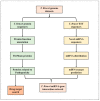Genome-Wide Screening for Pathogenic Proteins and microRNAs Associated with Parasite-Host Interactions in Trypanosoma brucei
- PMID: 36354791
- PMCID: PMC9695099
- DOI: 10.3390/insects13110968
Genome-Wide Screening for Pathogenic Proteins and microRNAs Associated with Parasite-Host Interactions in Trypanosoma brucei
Abstract
Tsetse flies are a type of blood-sucking insect living in diverse locations in sub-Saharan Africa. These insects can transmit the unicellular parasite Trypanosoma brucei (T. brucei) which causes African trypanosomiasis in mammals. There remain huge unmet needs for prevention, early detection, and effective treatments for this disease. Currently, few studies have investigated the molecular mechanisms of parasite-host interactions underlying African trypanosomiasis, mainly due to a lack of understanding of the T. brucei genome. In this study, we dissected the genomic and transcriptomic profiles of T. brucei by annotating the genome and analyzing the gene expression. We found about 5% of T. brucei proteins in the human proteome, while more than 80% of T. brucei protein in other trypanosomes. Sequence alignment analysis showed that 142 protein homologs were shared among T. brucei and mammalian genomes. We identified several novel proteins with pathogenic potential supported by their molecular functions in T. brucei, including 24 RNA-binding proteins and six variant surface glycoproteins. In addition, 26 novel microRNAs were characterized, among which five miRNAs were not found in the mammalian genomes. Topology analysis of the miRNA-gene network revealed three genes (RPS27A, UBA52 and GAPDH) involved in the regulation of critical pathways related to the development of African trypanosomiasis. In conclusion, our work opens a new door to understanding the parasite-host interaction mechanisms by resolving the genome and transcriptome of T. brucei.
Keywords: Trypanosoma brucei; bioinformatics; microRNA; parasite–host interaction.
Conflict of interest statement
The authors declare no conflict of interest.
Figures






Similar articles
-
Tsetse fly tolerance to T. brucei infection: transcriptome analysis of trypanosome-associated changes in the tsetse fly salivary gland.BMC Genomics. 2016 Nov 25;17(1):971. doi: 10.1186/s12864-016-3283-0. BMC Genomics. 2016. PMID: 27884110 Free PMC article.
-
A Host-Pathogen Interaction Reduced to First Principles: Antigenic Variation in T. brucei.Results Probl Cell Differ. 2015;57:23-46. doi: 10.1007/978-3-319-20819-0_2. Results Probl Cell Differ. 2015. PMID: 26537376 Review.
-
Gene co-expression network analysis of Trypanosoma brucei in tsetse fly vector.Parasit Vectors. 2021 Jan 22;14(1):74. doi: 10.1186/s13071-021-04597-6. Parasit Vectors. 2021. PMID: 33482903 Free PMC article.
-
Developmental changes and metabolic reprogramming during establishment of infection and progression of Trypanosoma brucei brucei through its insect host.PLoS Negl Trop Dis. 2021 Sep 20;15(9):e0009504. doi: 10.1371/journal.pntd.0009504. eCollection 2021 Sep. PLoS Negl Trop Dis. 2021. PMID: 34543277 Free PMC article.
-
Chemotherapeutic strategies against Trypanosoma brucei: drug targets vs. drug targeting.Curr Pharm Des. 2007;13(6):555-67. doi: 10.2174/138161207780162809. Curr Pharm Des. 2007. PMID: 17346174 Review.
Cited by
-
Genome-Wide Analysis Reveals Key Genes and MicroRNAs Related to Pathogenic Mechanism in Wuchereria bancrofti.Pathogens. 2024 Dec 10;13(12):1088. doi: 10.3390/pathogens13121088. Pathogens. 2024. PMID: 39770348 Free PMC article.
-
Targeting Trypanothione Synthetase and Trypanothione Reductase: Development of Common Inhibitors to Tackle Trypanosomatid Disease.Pharmaceuticals (Basel). 2025 Aug 11;18(8):1182. doi: 10.3390/ph18081182. Pharmaceuticals (Basel). 2025. PMID: 40872574 Free PMC article. Review.
References
-
- Rogerson E., Pelletier J., Acosta-Serrano A., Rose C., Taylor S., Guimond S., Lima M., Skidmore M., Yates E. Variations in the Peritrophic Matrix Composition of Heparan Sulphate from the Tsetse Fly, Glossina morsitans morsitans. Pathogens. 2018;7:32. doi: 10.3390/pathogens7010032. - DOI - PMC - PubMed
-
- World Health Organization Trypanosomiasis, Human African (Sleeping Sickness) 2022. Available online: https://www.who.int/news-room/fact-sheets/detail/trypanosomiasis-human-a...
Grants and funding
LinkOut - more resources
Full Text Sources
Research Materials

